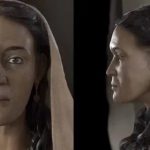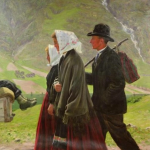A Mesolithic cave situated in Randaberg, located on the west coast of Norway, revealed the remains of a Stone Age teenager who lived over 8,300 years ago.
This discovery, known as Vistegutten, is considered one of Norway’s oldest skeletons and has recently been presented at the Hå Gamle Prestegard Museum. Through a pioneering reconstruction technique, the boy’s features, including his “unusual skull,” have been brought to life, giving us a glimpse into the life of a Stone Age teenager and contributing to our understanding of the region’s history.
Vistegutten, or “the boy from Viste,” was relatively small for his time, standing only 4 feet 1 inch (125 cm) tall. He had a condition called scaphocephaly, causing his skull to grow backward rather than sideways, which resulted in an unusual appearance. Despite this, he was a healthy boy and did not suffer from any developmental or intellectual disabilities.
The use of Artificial Intelligence (AI) in art has gained popularity in the visual arts field, but historians and archaeologists have also started to utilize it for reconstructing historical figures and their appearances. This technique has been particularly useful in cases where traditional reconstruction methods were not feasible, as in the case of Vistegutten.
Recently, a group of Swedish artists and coroners collaborated to reconstruct the face of a Stone Age woman who lived 4,000 years ago. Previously, they had also reconstructed the face of an 8,000-year-old man. A new report by Science Post suggests that researchers have attempted to reconstruct the face of a woman who was initially believed to be a man.
Swedish forensic artist Oscar Nilsson, who created the boy’s likeness, previously worked on facial reconstructions of ancient individuals and utilized his artistic judgment to create a “neutral and believable” face of Vistegutten, a Stone Age teenager. The reconstruction provides a glimpse into what the teenager may have looked like and enables modern viewers to connect with someone who lived thousands of years ago.
While the boy’s lower jaw was smaller than average, his teeth were in relatively good condition. However, his hair colour, eye colour, and skin tone were unknown, so Nilsson had to rely on his expertise to produce an accurate reconstruction. The final result portrays the teenager with short, curly hair and a serious expression, as if in contemplation, with his head tilted slightly downward.
The remains of the boy were found leaning against a cave wall, leading some to speculate that he died alone. However, there is no concrete evidence to support this theory, and the cause of his death remains unknown. Some researchers suggest that his death may have been tragic, with speculations that he may have lost his balance while fishing.
The innovative facial reconstruction technique has once again allowed us to explore ancient history, this time through the life of a Norwegian boy named Vistegutten. The discovery of both the cave and the child serves as a reminder that people in the past were similar to those in present times, despite inhabiting a vastly different world. Meanwhile, the facial reconstruction enables us to have a face-to-face interaction with Vistegutten, an opportunity that was previously unavailable.




